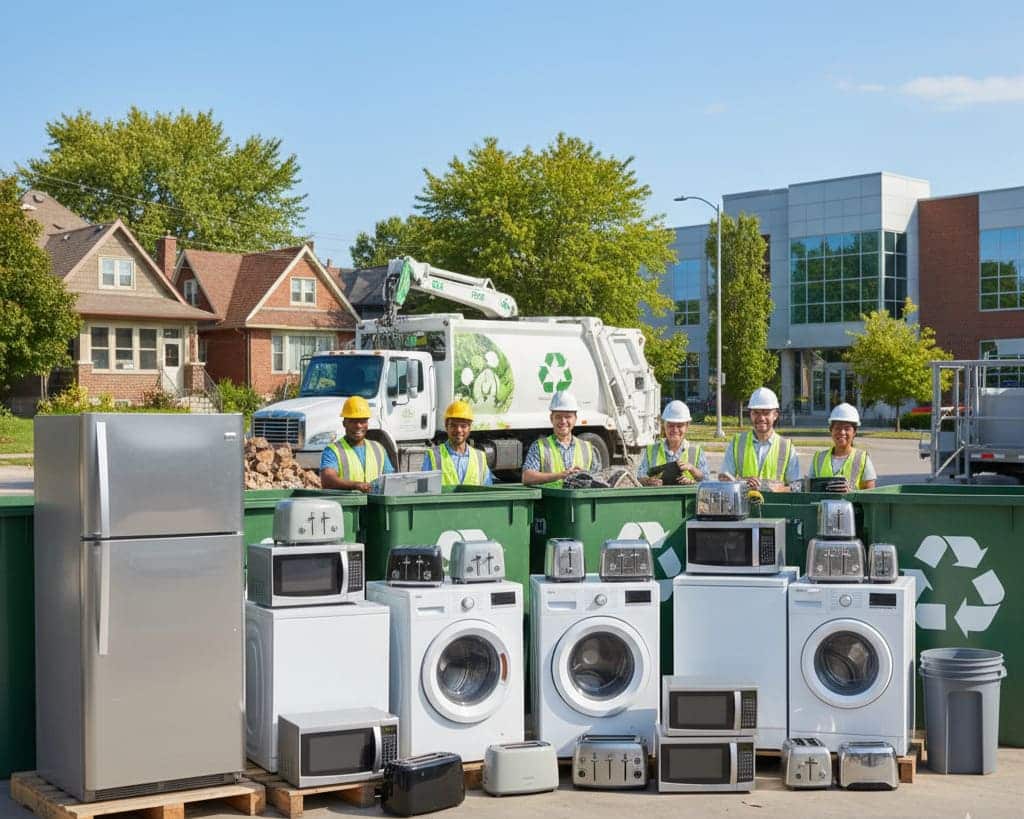Old fridges, washing machines, toasters, and microwaves pile up in basements and garages. Getting rid of them responsibly keeps hazardous materials out of landfills, recovers valuable metals, and prevents data or safety risks. This practical guide to
Appliance Recycling Winnipeg walks homeowners through local drop-off options, retailer take-backs, how to prepare small and large appliances, and when a pickup service like Mr. Garbage is the easiest, safest choice.
I’ll include local references, practical how-to steps, and trustworthy sources so you can move an appliance out of the house and into the right recycling stream, with minimal fuss.
What “Appliance Recycling Winnipeg” means and why it matters
Appliance recycling is the process of collecting end-of-life appliances, removing hazardous components (like refrigerants and batteries), recovering reusable parts and metals, and routing the rest to approved processors. Proper routes prevent harmful materials from entering the environment and keep materials circulating back into manufacturing. For Winnipeg residents, municipal depots, stewardship programs, and authorized private processors are the right place to start.
Why take the time?
- Appliances often contain refrigerants, heavy metals, and electronic components that require specialist handling.
- Recycling recovers steel, copper, aluminum, and other materials with real reuse value.
- Proper disposal avoids hazards like leaking refrigerant or batteries and protects sanitation workers and the environment.
Where to recycle appliances in Winnipeg
Appliance Recycling Winnipeg: City depots and municipal routes
Winnipeg’s 4R depots are the municipal starting point for many household items, including many small and large appliances. The depots list accepted items and are a reliable place to drop off working or non-working appliances that municipalities accept. For larger or unusual items, the Brady Road Resource Management Facility is the main municipal hub and may be the appropriate destination. Check the City of Winnipeg pages before you go to confirm current acceptance and hours.
Appliance Recycling Winnipeg: Stewardship and provincial programs
Some appliances and specific equipment are covered by provincial or producer stewardship programs. These programs manage collection networks and ensure materials are processed by certified handlers. For example, programs exist to handle large appliances and white goods in ways that recover refrigerants and valuable metals while complying with provincial rules. Efficiency or appliance-recycling programs in Manitoba list accepted items and pickup options.
Appliance Recycling Winnipeg: Private recyclers and reuse partners
Local private recyclers, pallet and scrap metal yards, and reuse charities often accept working appliances or appliance parts. They may repair, resell, or salvage components. For heavy items or mixed loads, private providers can offer pickups and will route materials to the correct end market.
Mr. Garbage coordinates pickups and works with approved downstream partners to make sure appliances are processed appropriately.
What to do with toasters, kettles, and blenders
Appliance Recycling Winnipeg: Small appliance options
Small household appliances are often accepted at municipal depots and by electronics-recycling programs. Some retailers accept smaller appliances as part of in-store recycling or take-back programs. If an item still works, consider donating to a local charity or reuse store first; otherwise, check your local depot or a certified recycler. Recycle My Electronics and similar programs maintain locators for many small devices.
Recycle My ElectronicsHow to prepare small appliances for recycling
- Unplug and clean the appliance, and remove batteries where applicable.
- If the appliance contains a battery, tape the terminals or remove the battery and recycle it through a battery program like Call2Recycle.
- Bundle cords and place smaller items in a container for transport to avoid losing pieces.
These simple steps speed acceptance at drop-off points and reduce hazards during handling.
Large appliance recycling: Fridges, stoves, washers, and dryers
Appliance Recycling Winnipeg: Special handling for large appliances
Large appliances commonly contain refrigerants, oils, and other components that must be removed safely. That’s why large white goods often require a municipal depot or a qualified recycler who can recover refrigerants and prepare units for metal recycling. Winnipeg’s depots accept many large appliances; check the accepted-items list before you travel. Efficiency programs and appliance services list pickup and drop-off procedures specific to bulky appliances.
Preparing large appliances for pickup or drop-off
- Disconnect and empty the appliance before transport.
- Secure doors (tape closed) for safety in transit.
- Remove food and defrost refrigerators and freezers before dropping them off.
- If a unit contains refrigerant, confirm the drop-off or recycler will safely recover it. Many municipal and private processors handle refrigerant reclamation as part of their process.
Retailer programs: Can big-box stores help?
Appliance Recycling Winnipeg: Best Buy, Home Depot, and retailer take-backs
Major retailers often run recycling and haul-away programs. Best Buy offers haul-away services and coordinates recycling of certain appliances when a new appliance is delivered; they also maintain a recycling FAQ explaining which items they accept and how to prepare them. Home improvement retailers may participate in battery and small-electronics drop-off programs and occasionally run appliance-related recycling services. Always check the specific store’s program page before you go, because accepted items and rules vary by location.
What retailers can’t do?
Retailer programs are convenient but have limits. Some large appliances may not be accepted in-store and can require a haul-away arrangement or drop-off at a municipal depot. If your unit contains hazardous materials, verify the retailer’s capability to handle them or ask for a referral to a certified processor.
bestbuy.comSafety, hazardous components, and environmental rules
Appliance Recycling Winnipeg: refrigerants and hazardous parts
Refrigerators, freezers, air conditioners, and dehumidifiers contain refrigerants and oils that must be reclaimed by certified technicians. That reclamation prevents ozone depletion and greenhouse gas releases. Municipal and private processors typically perform or arrange for refrigerant recovery as part of accepted appliance recycling. Always confirm that your chosen drop-off or pickup service handles refrigerants correctly.
Efficiency ManitobaElectronics, PCBs, and hazardous components
Some older appliances may contain legacy hazardous components like PCBs, mercury switches, or hazardous flame retardants. Depots and certified recyclers are trained to identify and separate these parts so they can be treated or disposed of safely. Disclose the appliance age and condition if you suspect unusual components; depot staff will advise on the correct path.
City of WinnipegHow appliances are processed after drop-off
Once appliances reach a depot or recycler, they typically follow these steps:
- Decontamination and hazardous removal: refrigerants and batteries removed by trained technicians.
- Dismantling: doors, plastic components, and wiring are separated from metal frames.
- Materials recovery: metals (steel, aluminum, copper) and plastics are sorted for recycling or energy recovery.
- Resale or parts salvage: working components may be refurbished or sold as spare parts.
This chain-of-custody ensures environmental and worker safety while keeping salvaged material in the circular economy. Certified processors and stewardship programs are audited to maintain standards.
Real-world example: How a Winnipeg homeowner handled an appliance upgrade
A homeowner replacing an old refrigerator took a mixed approach: they arranged for the new appliance delivery team to remove the old unit where possible, used the city’s 4R depot for an aging microwave and small electronics, and booked a pickup for scrap metal and other bulky components. The refrigerator’s refrigerant was reclaimed by the processor, and the unit’s steel and compressor parts were recovered for recycling. The small appliances were assessed for reuse and, where broken, shredded for material recovery. That multi-route approach kept the most hazardous parts in the right hands and diverted valuable materials from landfill.
Expert quote: “A simple split strategy, donate when possible, drop off at depots for small items, and arrange certified recycling for large units, protects homeowners and keeps materials valuable,” says a provincial appliance recycling coordinator.
When to call Mr. Garbage: Pickup advantages and what they handle
Mr. Garbage provides an easy, documented option for homeowners who prefer convenience or have heavy or awkward appliances to move. Services include:
- On-site pickup and safe transport.
- Sorting of appliances into the correct reuse or recycling streams.
- Coordination with certified downstream processors for refrigerant recovery and material reclamation.
- Secure removal of small electronics and separation of batteries and cords.
Use Mr. Garbage when you want a single point of contact to remove, sort, and route appliances, especially useful for seniors, busy families, or renovation projects where logistics are a hassle. Mentioning
Mr. Garbage here is practical: many homeowners choose a vetted local partner to reduce risk and save time.
Simple homeowner checklist: Prepare your appliance for recycling
- Disconnect and clean the appliance.
- Remove loose parts, food, and accessories.
- Secure doors for transport and tape or block them shut.
- Defrost refrigerators and freezers in advance if you can.
- Remove batteries and tape terminals as needed.
- If an appliance contains refrigerant, confirm that recovery will be done by the processor.
This short prep protects handlers and speeds processing at the depot or during pickup.
The environmental and social benefits of appliance recycling
Recycling appliances reduces the need for virgin materials, lowers emissions tied to extraction and manufacturing, and keeps hazardous elements from entering the ecosystem cycles. Reuse programs also support local charities and communities by making working appliances available to those in need. Homeowner participation in the right recycling routes scales into measurable local environmental benefits.
Common questions about appliance recycling
Are appliances recyclable?
Yes, many appliance components are recyclable. Metals, some plastics, and certain components are routinely recovered. Appliances with hazardous materials must be processed correctly, which is why depots, stewardship programs, and certified recyclers are essential.
Does Best Buy recycle appliances?
Best Buy offers haul-away and recycling services for some appliances, often tied to new deliveries or specific haul-away programs. Check the Best Buy recycling page for the items they accept and how their haul-away service operates in your area.
Where can I recycle small appliances near me?
Start with the City of Winnipeg’s 4R depots and the Recycle My Electronics locator for nearby options. Many reuse shops and community charities will accept working small appliances for donation.
Conclusion
Appliance Recycling Winnipeg is straightforward when you follow the right sequence: donate or sell working items, drop small appliances at a depot or authorized e-waste site, and route large white goods through municipal depots, stewardship programs, or certified recyclers that recover refrigerants and hazardous parts. When moving heavy or awkward items feels like a hassle, Mr. Garbage offers pickup, sorting, and coordinated routing to approved processors so your appliances are handled responsibly and safely.
Ready to recycle an old fridge, washer, or small kitchen appliance? Visit
Mr. Garbage to schedule a secure pickup or get guidance on the best drop-off locations in Winnipeg. Let us take the heavy lifting and make sure your appliance goes back into the right recycling stream.
Frequently Asked Questions (FAQs)
Q1: Where can I recycle appliances in Winnipeg?
A1: Start with the City of Winnipeg’s 4R depots for many small and large appliances. For specific items like refrigerators with refrigerant, check depot guidance or contact certified appliance recyclers. If transport is difficult, book a pickup with a trusted local service such as Mr. Garbage.
Q2: Does Best Buy recycle appliances?
A2: Best Buy offers haul-away and recycling services for a range of appliances, typically tied to new deliveries or specific haul-away programs. Check Best Buy’s recycling pages for details about which items they accept.
Q3: How should I prepare a refrigerator for recycling?
A3: Empty and defrost the fridge, secure the door for transport, and confirm the processor will reclaim the refrigerant. If you’re unsure how to defrost safely, ask the pickup or depot staff for guidance.
Q4: Can I recycle small kitchen appliances at a depot?
A4: Yes. Many municipal depots and electronics recycling programs accept small kitchen appliances. If an item still works, consider donating it first; otherwise, take it to an approved drop-off location.
Q5: What happens to appliances after they are dropped off?
A5: Appliances are decontaminated (refrigerants and batteries removed), dismantled, and sorted. Metals and plastics are recovered for recycling; working components may be refurbished and resold. Certified processors follow audited practices to ensure safe handling and proper material recovery.

